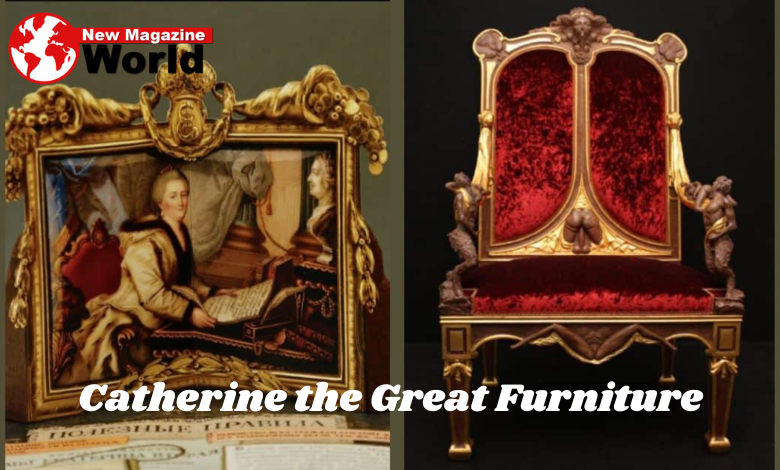Catherine the Great Furniture: A Glimpse into the Opulence of the Russian Empress

Catherine the Great, the Empress of Russia from 1762 to 1796, is remembered as one of the most powerful and influential women in history. Her reign was marked by significant cultural, political, and economic advancements, as well as a deep appreciation for the arts. Among the many legacies she left behind, one of the most fascinating is her taste in furniture. The phrase Catherine the Great furniture refers to the opulent, luxurious, and often extravagant pieces that adorned her palaces. In this article, we will explore the history, style, and significance of Catherine the Great furniture, shedding light on how it reflected the grandeur of her reign.
The Historical Context of Catherine the Great Furniture
Catherine the Great ascended to the Russian throne in 1762 after a coup d’état that deposed her husband, Peter III. Her reign, which lasted until her death in 1796, is often referred to as the Golden Age of Russia. During this period, Catherine embarked on a series of ambitious projects to modernize Russia and bring it closer to Western Europe. This modernization included a strong emphasis on the arts, architecture, and interior design.
Catherine’s passion for the arts was evident in her patronage of renowned artists, architects, and craftsmen from across Europe. She was particularly influenced by the styles and tastes of France, which was the cultural epicenter of Europe at the time. This influence is reflected in the design of the furniture that filled her palaces, which combined Russian craftsmanship with European elegance.
The Style and Characteristics of Catherine the Great Furniture
Catherine the Great furniture is characterized by its opulence, intricate craftsmanship, and use of luxurious materials. The pieces often featured elaborate carvings, gilded accents, and rich upholstery. The style of furniture during her reign can be broadly categorized into two periods: the Rococo period and the Neoclassical period.
Rococo Influence on Catherine the Great Furniture
In the early years of Catherine’s reign, Rococo was the dominant style in European art and design. Originating in France, Rococo is known for its ornate and asymmetrical designs, light colors, and playful themes. Catherine the Great was enamored with this style, and it heavily influenced the furniture created during the early years of her rule.
Rococo furniture in Catherine’s palaces often featured curved lines, intricate scrollwork, and floral motifs. Chairs, tables, and cabinets were adorned with delicate carvings of shells, leaves, and flowers, all gilded to emphasize their luxurious nature. The upholstery was typically made from rich fabrics such as silk and velvet, often in pastel colors like light blue, pink, and gold.
One of the most famous examples of Rococo furniture from Catherine’s era is the furniture designed by the French ébéniste (cabinetmaker) David Roentgen. Roentgen’s work was highly prized by European royalty, and Catherine was one of his most important patrons. His furniture pieces for the Empress were masterpieces of both form and function, featuring hidden compartments, mechanical devices, and intricate marquetry.
Neoclassical Influence on Catherine the Great Furniture
As Catherine’s reign progressed, the Rococo style began to give way to Neoclassicism, a style that drew inspiration from the art and architecture of ancient Greece and Rome. Neoclassicism emphasized symmetry, simplicity, and grandeur, in contrast to the playful and ornate nature of Rococo.
Catherine the Great was a strong advocate for Neoclassicism, seeing it as a reflection of the rationalism and order she sought to bring to Russia. Neoclassical furniture in her palaces featured clean lines, geometric shapes, and motifs inspired by classical antiquity, such as laurel wreaths, acanthus leaves, and Greco-Roman columns.
The transition to Neoclassicism is particularly evident in the furniture of Catherine’s later years, with pieces often showcasing a blend of Russian and classical European elements. Mahogany and other dark woods became more prevalent, replacing the lighter tones of the Rococo period. Gilding remained a prominent feature, but it was used more sparingly to highlight the architectural form of the furniture rather than to create elaborate decorative patterns.
The Palaces Adorned with Catherine the Great Furniture
Catherine the Great’s palaces were the epitome of luxury and served as the perfect backdrop for her exquisite furniture. Two of the most famous palaces associated with her are the Winter Palace in St. Petersburg and the Catherine Palace in Tsarskoye Selo.
The Winter Palace
The Winter Palace, located in the heart of St. Petersburg, was the official residence of the Russian monarchs and one of the most opulent buildings in the world. Catherine the Great made significant renovations to the palace, filling it with art, sculptures, and, of course, her luxurious furniture.
The interior of the Winter Palace was designed to impress. Grand halls and intimate chambers alike were adorned with Catherine the Great furniture, showcasing both Rococo and Neoclassical styles. The palace’s many rooms, including the famous Malachite Room and the Pavilion Hall, featured furniture that reflected Catherine’s refined taste and her desire to demonstrate Russia’s cultural sophistication to the world.
The Catherine Palace
The Catherine Palace, named after Catherine I (Peter the Great’s wife) but later expanded and renovated by Catherine the Great, is another stunning example of the Empress’s taste in architecture and interior design. Located in Tsarskoye Selo (now Pushkin), just outside St. Petersburg, the palace is known for its grandeur and the famous Amber Room.
The Catherine Palace was a showcase of Neoclassical design during Catherine the Great’s reign. The furniture here was more restrained than in the Winter Palace, reflecting the Empress’s evolving taste for the classical and the orderly. The Great Hall and the Portrait Hall, among other rooms, were filled with furniture that embodied the Neoclassical ideals of symmetry, proportion, and harmony.
The Legacy of Catherine the Great Furniture
Catherine the Great’s influence on furniture design extended far beyond her lifetime. Her patronage of the arts helped to elevate Russian craftsmanship to new heights, and the furniture created during her reign is still celebrated for its beauty and technical brilliance.
Today, pieces of Catherine the Great furniture can be found in museums and private collections around the world. These pieces are highly prized by collectors and historians alike, not only for their aesthetic value but also for the glimpse they offer into the life and times of one of history’s most powerful women.
The legacy of Catherine the Great furniture is also evident in the continued influence of Rococo and Neoclassical styles in interior design. While these styles have evolved over the centuries, the principles of elegance, luxury, and craftsmanship that defined Catherine’s taste continue to inspire designers today.
Conclusion: The Enduring Appeal of Catherine the Great Furniture
Catherine the Great furniture is more than just a collection of luxurious pieces; it is a testament to the grandeur and sophistication of her reign. The furniture that adorned her palaces reflects not only her personal taste but also her vision for Russia as a cultural and artistic powerhouse. From the ornate Rococo designs of her early years to the classical elegance of Neoclassicism, Catherine’s influence on furniture design is undeniable.
Today, Catherine the Great furniture remains a symbol of opulence and refinement. Whether found in the grand halls of her palaces or in the collections of museums, these pieces continue to captivate and inspire. They serve as a reminder of the Empress’s lasting impact on the arts and her enduring legacy as one of history’s great patrons of culture.





